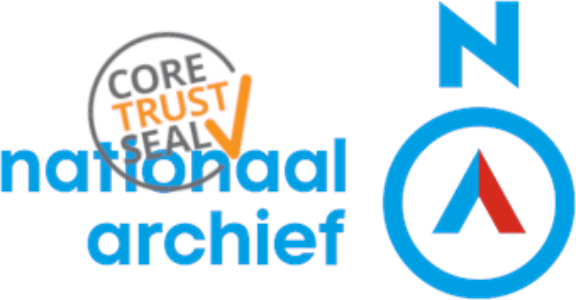On Tuesday, September 12, 2024, we received good news at the National Archives of the Netherlands (NAN). Our digital repository (e-Depot) received CoreTrustSeal certification for another three years and we are proud of that. But this recertification was not a piece of cake. More was needed than simply resubmitting our application from the previous time. In this blog, Marin Rappard and I share seven experiences and corresponding advice.
1) New requirements, new text
CoreTrustSeal updates the CoreTrustSeal Trustworthy Data Repositories Requirements, or the requirements for certification, every few years. We also had to deal with a new version. Clearer and better, but it took time (see also 3) to adjust our application text. For example, persistent identifiers are now discussed in more detail and it is stated that you cannot obtain a certificate without them. Last time, the question was limited to “What persistent identifier systems does the repository use?”
Our advice: make sure you take into account the differences between the old and new requirements.
2) New application, new questions
If you are going to recertify while little has changed in your situation, you might think that you will be done quickly. But that is not automatically the case. Firstly, the new requirements may require new answers (see 1). Then there is a good chance that other reviewers will assess your application. They will ask different questions. One of our reviewers appeared to be particularly interested in private archives, while that was hardly discussed in the feedback the first time.
Our advice: past experiences are no guarantee for the future. View each application for recertification as a new application that new reviewers will look at.
3) Shorter is not always better
The application text for our first certification was quite long, with a lot of repetition of information. We provided a number of fully translated documents as accompanying documentation. To make it easier for the reviewers and the public, we opted for an easy-to-read, continuous story with shorter explanations this time. Cross-references meant that fewer repetitions were necessary.
The feedback from the reviewers demonstrated that this might not have been a good idea. We saw a number of questions about things we thought we answered elsewhere in our text. And that we referred to. It became clear to us that we would have made it easier for the reviewers, or at least these reviewers, if our explanation for each requirement had been independently understandable.
Our advice: make your responses to each requirement as independently understandable as possible.
4) No more National Archives?
Sometimes you must think outside your box! Your right to exist can be very solid, because you are, for example, a national, regional or city archive. However, you must be able to explain this and show that you have thought about a backup plan. For example, this time we were asked an interesting question about our succession planning: what if NAN would cease to exist?
Our advice: think carefully about the guarantees of your organizational continuity for requirement 3, even if you reasonably believe that you are assured of your continued existence. In any case, thinking about the smallest, but also the biggest, almost unthinkable risks during the certification process is a good challenge. The result gives extra confidence in your digital archive.
5) Together you get further
You will undoubtedly need input from different colleagues who fulfill different roles. This is positive for working relationships and connections in your department and between departments. You get to know the organization in an intensive way. However, the dependency on the agendas of others will slow down the certification process considerably.
Our advice: alone you go fast, but together you get further. Work together with different colleagues who fulfill different roles. Then you can also be proud of the certificate you have obtained, together. This was also one of the tips we gave after obtaining our first certification (https://www.nationaalarchief.nl/archiveren/nieuws/acht-tips-voor-het-certificeren-van-een-e-depot, in Dutch). We cannot emphasize it enough.
6) Certification takes time
Recertification too: in August 2022, CoreTrustSeal reminded us of the expiration of our certificate and two years later we had renewed it. On the one hand, as an organization, you need time to write your application and respond to feedback. On the other hand, CoreTrustSeal needs time for the review process. As a result, we were without a certificate for a while.
Our advice: recertification will (also) require time. Start your recertification process in time if you want to have back-to-back certificates.
7) Everything in one place
Certification is good for your organization, for several reasons. Obtaining a certificate increases the trust in your organization among your visitors and stakeholders, but also internally. It creates shared pride in obtaining that certificate. And in recent years we noticed how useful it was and is that for certification, we had collected a lot of documentation in one place. We referred several (inter)national colleagues, who wanted to know more about how we work, to our CoreTrustSeal documentation. Even for internal colleagues it was sometimes a handy reference work.
Our advice: if you are ready for it, opt for certification and then recertification. It is good for your organization, for several reasons.
Conclusion
As the National Archives we are proud that we have again certified our e-Depot according to CoreTrustSeal. In this blog Marin Rappard and I have shared seven experiences and corresponding advice. Hopefully you will find it useful if you are considering certification, are in the process of certifying, or are working on recertification.
Links
- You can find our approved application text here: https://dataverse.nl/dataset.xhtml?persistentId=doi:10.34894/RW3I5N.
- The web page with our accompanying documentation can be found here: https://www.nationaalarchief.nl/en/archive/knowledge-base/coretrustseal.
- More certified digital archives can be found here: https://amt.coretrustseal.org/certificates/.
- Everything about CoreTrustSeal can be found here: https://www.coretrustseal.org/.


